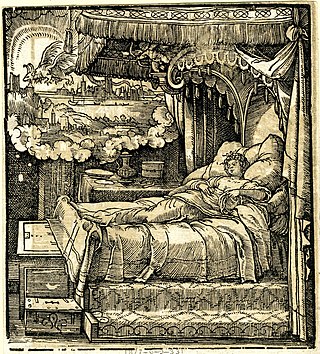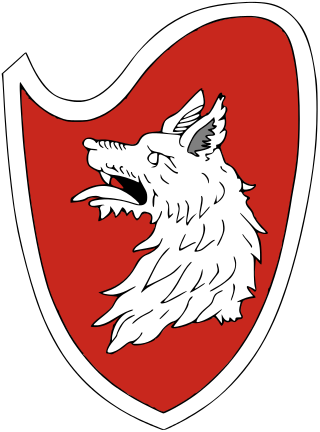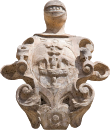
Gjergj Arianiti (1383–1462) was an Albanian feudal lord who led several successful campaigns against the Ottoman Empire. He was the father of Donika, Skanderbeg's wife, as well as the grand-uncle of Moisi Arianit Golemi. Gjergj Arianiti was Skanderbeg's ally within League of Lezhë before abandoneding the alliance after the defeat in Berat in 1450. He later returned. Robert Elsie emphasizes that Arianiti was often Skanderbeg's rival. He allied with the Kingdom of Naples in 1446, left his alliance with Skanderbeg by 1449 and allied with Venice in 1456. However his daughter married Skanderbeg and he remained officially part of the League of Lezhe, continuing to fight Ottomans successfully up to his death in 1462.
Piana degli Albanesi is a comune with 6,128 inhabitants in the Metropolitan City of Palermo, Sicily. The official name of the town was Piana dei Greci until 1941. The municipality is situated on a mountainous plateau and encircled by high mountains, on the eastern side of the imposing Mount Pizzuta, the city, which is mirrored on a large lake, is 24 km from the metropolitan capital.

Bisignano is a town and comune in the province of Cosenza, part of the Calabria region of southern Italy. It is situated on hills in the Crati valley, between the Pollino and Sila National Parks. The town has historically been settled and inhabited by an Arbëreshë community

The Kastrioti were an Albanian noble family, active in the 14th and 15th centuries as the rulers of the Principality of Kastrioti. At the beginning of the 15th century, the family controlled a territory in the Mat and Dibra regions. The most notable member was Gjergj Kastrioti, better known as Skanderbeg, regarded today as an Albanian hero for leading the resistance against Mehmed the Conqueror's efforts to expand the Ottoman Empire into Albania. After Skanderbeg's death and the fall of the Principality in 1468, the Kastrioti family gave their allegiance to the Kingdom of Naples and were given control over the Duchy of San Pietro in Galatina and the County of Soleto, now in the Province of Lecce, Italy. Ferrante, son of Gjon Kastrioti II, Duke of Galatina and Count of Soleto, is the direct ancestor of all male members of the Kastrioti family today. Today, the family consists of two Italian branches, one in Lecce and the other in Naples. The descendants of the House of Kastrioti in Italy use the family name "Castriota Scanderbeg".

Aldo Fabrizi was an Italian actor, director, screenwriter and comedian, best known for the role of the heroic priest in Roberto Rossellini's Rome, Open City and as partner of Totò in a number of successful comedies.

The Lives of the Most Excellent Painters, Sculptors, and Architects, often simply known as The Lives, is a series of artist biographies written by 16th-century Italian painter and architect Giorgio Vasari, which is considered "perhaps the most famous, and even today the most-read work of the older literature of art", "some of the Italian Renaissance's most influential writing on art", and "the first important book on art history".
The former Italian Catholic diocese of Bisignano, in Calabria, existed from the eighth century until 1818. In that year it was united with the diocese of San Marco, to create the diocese of San Marco e Bisignano. More recently, Bisignano passed to the archdiocese of Cosenza-Bisignano.

The Muzaka were a noble Albanian family that ruled over the region of Myzeqe in the Late Middle Ages. The Muzaka are also referred to by some authors as a tribe or a clan. The earliest historical document that mentions the Muzaka family is written by the Byzantine historian Anna Komnene. At the end of the 13th and beginning of the 14th century members of the Muzaka family controlled a region between the rivers of Devoll and Vjosë. Some of them were loyal to the Byzantine Empire while some of them allied with Charles of Anjou who gave them impressive Byzantine-like titles in order to subdue them more easily. During a short period, Serbian Emperor Stefan Dušan occupied Albania including domains of Muzaka family but after Dušan's death they regained their former possessions. After the Battle of Savra in 1385 the territory of Albania came under the Ottoman Empire; they served the Ottomans until 1444 when Theodor Corona Musachi joined Skanderbeg's rebellion. When the Ottomans suppressed Skanderbeg's rebellion and captured the territory of Venetian Albania in the 15th century many members of the Muzaka family retreated to Italy. Those who stayed in Ottoman Albania lost their feudal rights, some converted to Islam and achieved high ranks in the Ottoman military and administrative hierarchy.

Vrana, historically known as Vrana Konti was an Albanian military leader who was distinguished in the Albanian-Turkish Wars as one of the commanders of Gjergj Kastrioti Skanderbeg, of whom he was one of the closest councillors. He probably belonged to the class of small lords who were tied to the Kastrioti family and possibly belonged to a common lineage (fis) with them. In his youth, he fought as a mercenary in the armies of Alfonso the Magnanimous. The term conte ("count") with which he became known in historical accounts didn't refer to an actual title he held, but to his status as a figure of importance.

The Italo-Albanian Catholic Church or Italo-Albanian Byzantine-Catholic Church is one of the 23 Eastern Catholic Churches which, together with the Latin Church, compose the Catholic Church. It is an autonomous (sui juris) particular church in full communion with the Pope of Rome, directly subject to the Roman Congregation for the Oriental Churches, but which follows the Byzantine Rite, the ritual and spiritual traditions that are common in most of the Eastern Orthodox Church. It uses two liturgical languages: Koine Greek, the traditional language of the Eastern Churches, and Albanian, the native language of most of its adherents.

Voisava was the wife of Gjon Kastrioti, an Albanian nobleman from the House of Kastrioti. They had nine children together, one of whom was the Albanian national hero Gjergj Kastrioti, better known as Skanderbeg.

Gjon II Kastrioti, was the son of Gjergj Kastrioti Skanderbeg, the Albanian national hero, and of Donika Kastrioti, daughter of the powerful Albanian prince, Gjergj Arianiti. He was for a short time Lord of Kruja after his father's death, then Duke of San Pietro in Galatina (1485), Count of Soleto, Signore of Monte Sant'Angelo and San Giovanni Rotondo. In 1495, Ferdinand I of Naples gave him the title of the Signore of Gagliano del Capo and Oria. While in his teens, he was forced to leave the country after the death of his father in 1468. He is known also for his role in the Albanian Uprisings of 1481, when, after reaching the Albanian coast from Italy, settling in Himara, he led a rebellion against the Ottomans. In June 1481, he supported forces of Ivan Crnojević to successfully recapture Zeta from the Ottomans. He was unable to re-establish the Kastrioti Principality and liberate Albania from the Ottomans, and he retired in Italy after three years of war in 1484.
The Ottoman invasion of Albania in 1452 was a campaign by the newly acceded Ottoman sultan Mehmed II against Skanderbeg, the chief of the League of Lezhë. Shortly after the first siege of Krujë, Murad II died in Edirne, and was succeeded by his son Mehmed II. Mehmed ordered nearly annual invasions of Albania which often resulted in multiple battles in one year. The first of these expeditions was sent in 1452 under the dual command of Hamza Pasha and Tahip Pasha, with an army of approximately 25,000 men.

Skanderbeg has been the subject of many works of art and literature and the inspiration for countless others. It is a motif in the visual arts, the performing arts, poetry, prose and music.
Nicholas Dukagjini was an Albanian nobleman of the Dukagjini family in the 15th century. He was the son of Pal Dukagjini, one of the founding members of the League of Lezhë. Nicholas Dukagjini fled to Italy after the second Siege of Shkodra in 1479, but is well known for the return to his homeland two years later, together with Skanderbeg’s son Gjon Kastrioti and other noblemen to lead the armed movement against the Ottomans.

George Strez Balšić or Gjergj Balsha and his brothers Gojko and Ivan were the lords of Misia, a coastal area from the White Drin towards the Adriatic. The brothers were members of the Balšić noble family, which had earlier held Zeta. They participated in founding of the League of Lezhë, an alliance led by their maternal uncle Skanderbeg. George later betrayed Skanderbeg, by selling a domain to the Ottomans, while his two brothers continued to support Skanderbeg until his death and then continued to fight for the Venetian forces.
Andrea Thopia was a 15th century Albanian noble man whose domains included the territory of Scuria. He was a member of the Thopia family and one of the founders of the League of Lezhë.

The Albanian-Ottoman Wars (1432–1479) were a series of wars and revolts against the rising Ottoman Empire by Albanian feudal lords. The wars and revolts took place in present-day Albania, Montenegro, Kosovo, North Macedonia and South Serbia. In this period, Albanians under the leadership of Gjergj Arianiti and especially later under Skanderbeg resisted the Ottomans under two Sultans in over 30 battles. Skanderbeg continued this resistance until his death in 1468, and the Albanians persevered for another 11 years before being defeated.
Heraldry, as a scholarly discipline that deals with the study and origin of various symbols and elements, emerged in Albania towards the end of the 13th century. Over time, it has evolved as an inseparable component of European heraldry, encompassing its advancements, shifts and accomplishments.













